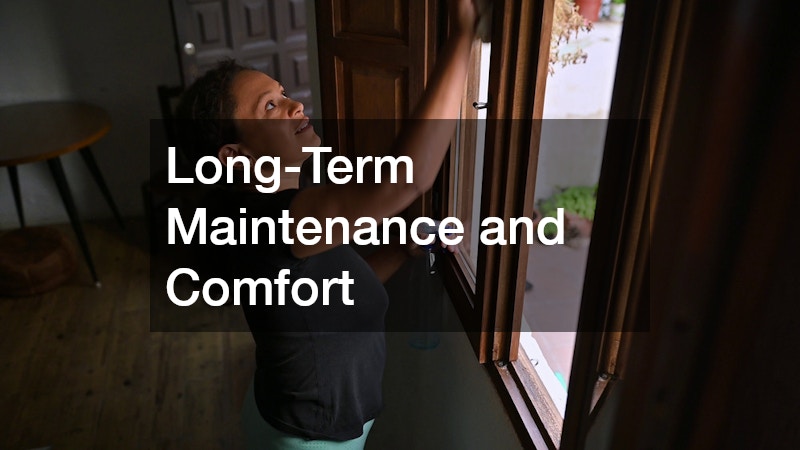Buying a home is one of the most significant milestones in anyone’s life. It’s not only a financial step but also a personal journey that marks stability, growth, and belonging. For many, the excitement of walking through the front door of their first house is a moment that will never be forgotten. Yet that moment comes only after careful planning, decision-making, and financial preparation.
The process can feel complicated, especially for those navigating it for the first time. Between choosing the right property, qualifying for a mortgage, arranging inspections, purchasing insurance, and planning the move, there are countless details to manage. Becoming a homeowner requires patience, attention to detail, and a willingness to learn along the way.

- Preparing Your Finances for Homeownership
- The Mortgage Process Demystified
- Home Inspections and What to Look For

- Protecting Your Investment With Insurance
- Planning Your Move and Settling In
- Making Repairs and Upgrades

- Long-Term Maintenance and Comfort
- Considering Future Options
- Exploring Your Neighborhood

- Finding the Right Property From the Start
Preparing Your Finances for Homeownership
Before you begin browsing properties, it’s important to have a clear picture of your financial readiness. Owning a home is more than just covering a monthly mortgage—it’s about being prepared for all the costs that come with maintaining a property. Property taxes, insurance, utilities, and routine upkeep can easily add hundreds of dollars each month to your expenses. If you don’t budget for these additional costs, you may find yourself stretched too thin after move-in.
A strong first step is calculating your debt-to-income ratio (DTI). This measures how much of your monthly income goes toward debt payments. Most lenders prefer to see a DTI below 36%, with housing costs making up no more than 28% of your gross monthly income. That means if you earn $6,000 per month, you should aim for a mortgage, taxes, and insurance payment no higher than $1,680. Running these numbers before you apply will save time and prevent disappointment later.
Saving for a down payment is another essential task. While it is possible to buy with as little as 3% down, a 20% down payment is ideal because it helps you avoid private mortgage insurance (PMI) and reduces your monthly payment significantly. Even if you cannot reach the 20% mark, every additional dollar you put down up front will reduce your long-term interest costs. Building a dedicated home savings account can help you track your progress and stay motivated.
This is where a financial advisor can play a critical role. They can review your income, debts, and long-term goals to provide a personalized savings plan. They may also advise you on boosting your credit score, paying down debt strategically, and preparing for the hidden costs of homeownership. If becoming a homeowner feels overwhelming, having an expert walk you through your financial picture can give you both confidence and clarity.
The Mortgage Process Demystified
Mortgages can feel confusing, but breaking them down step by step makes the process manageable. When becoming a homeowner, the first step is getting pre-approved, which involves a lender reviewing your credit, income, and debts to determine how much you can borrow. This not only helps you shop within your price range but also shows sellers that you’re a serious buyer. Pre-approval letters can make your offer more competitive, especially in hot real estate markets.
After pre-approval, it’s time to compare loan options. Fixed-rate mortgages are the most popular because they provide stability with an interest rate that doesn’t change. Adjustable-rate mortgages (ARMs) may start with a lower rate, but they carry the risk of increasing later on. For some buyers, government-backed loans such as FHA or VA mortgages may be the right fit, especially if they’re first-time buyers or veterans. Understanding the long-term costs of each loan type is essential because even a small difference in interest rates can add up to tens of thousands of dollars over the life of the loan.
Shopping around for lenders is equally important. Many buyers default to large banks, but smaller institutions often provide better service and competitive terms. Don’t overlook credit unions, which frequently offer lower fees and more personalized customer support. Since credit unions are member-focused rather than profit-driven, they may be more flexible in helping you secure favorable terms.
Once you’ve chosen a loan, your lender will guide you through the application, underwriting, and approval process. Be prepared to provide documentation such as pay stubs, tax returns, and bank statements. Having these documents ready in advance will make the process smoother.
Home Inspections and What to Look For
After your offer is accepted, the home inspection becomes one of the most critical steps in protecting your investment. Before becoming a homeowner, a thorough inspection can reveal hidden problems that may cost you thousands of dollars if left unaddressed. Skipping or rushing through this step could result in purchasing a property with serious defects you didn’t anticipate.
A professional inspector will examine the roof, foundation, plumbing, electrical systems, windows, and overall structural integrity. They’ll also look for signs of water damage, mold, pest infestations, and faulty appliances. While some issues may be minor, others could indicate long-term risks. This information not only helps you make an informed decision but also gives you leverage to negotiate repairs or price adjustments with the seller.
One area to pay particular attention to is the foundation inspection. Foundation issues can compromise the safety of the entire home and lead to uneven floors, cracked walls, or water intrusion. Repairing a damaged foundation can be one of the most expensive fixes you face when becoming a homeowner. For this reason, it’s worth hiring a specialist to assess the foundation in addition to the general home inspection.
Protecting Your Investment With Insurance
Once you’ve confirmed the home is structurally sound, the next step to becoming a homeowner is protecting it with insurance. Homeowners insurance provides financial coverage for damages, theft, or liability claims, and it’s often required by lenders as a condition of your mortgage. While it may feel like just another monthly expense, the protection it offers is invaluable.
A standard policy typically includes four key areas of coverage. Dwelling coverage protects the physical structure of your home, including walls, roofs, and built-in appliances. Personal property coverage protects your belongings such as furniture, electronics, and clothing. Liability coverage offers protection if someone is injured on your property, while loss-of-use coverage pays for additional living expenses if your home becomes uninhabitable due to damage.
However, it’s important to understand the limitations of standard coverage. Events like floods, earthquakes, and sewer backups are often excluded and require additional policies. If you live in an area prone to natural disasters, adding these extra protections is worth the investment.
Working with a trusted insurance agency can make this process easier. Independent agencies can compare quotes from multiple insurers and tailor coverage to your unique needs. They can also walk you through what’s covered, what isn’t, and where you may need additional protection.
Planning Your Move and Settling In
Closing day is exciting, but the work isn’t over yet. The moving process is often underestimated in terms of time, energy, and cost. Without a plan, moving can quickly become overwhelming. That’s why it’s important to start preparing weeks in advance.
Begin by decluttering your belongings. The less you move, the easier and cheaper the process becomes. Go room by room, donating or discarding items you no longer use. Next, pack strategically by labeling boxes with the room they belong to and a brief description of the contents. Keep essentials like toiletries, clothing, and important documents in a separate bag so you’re not digging through boxes on your first night.
When becoming a homeowner, hiring professional movers is another consideration. While it may be tempting to handle everything yourself, working with reputable local moving companies can save you time and reduce stress. Look for companies with transparent pricing, positive reviews, and insurance coverage in case of damage. Don’t wait until the last minute to book—moving companies often fill up quickly, especially during peak seasons.
Making Repairs and Upgrades
Even a newly built home may require small adjustments, and older homes often come with a list of repairs. While some projects can wait, others need to be tackled right away to ensure safety and comfort. Addressing these tasks early helps you settle in and prevents minor problems from turning into costly repairs.
For basic fixes like patching holes, repairing leaky faucets, or installing shelves, hiring a handyman service can be a smart choice. Handymen are generally more affordable than specialized contractors and can handle a variety of small tasks efficiently. Having someone knock out multiple repairs in a single visit can save both time and money.
For larger projects—such as electrical rewiring, roof replacement, or plumbing overhauls—it’s better to hire licensed specialists. Always request estimates from multiple providers and check reviews to ensure quality work. Attempting complicated repairs on your own may lead to safety hazards or expensive mistakes.
Long-Term Maintenance and Comfort
Homeownership doesn’t end once the move-in process is complete. In fact, one of the most important aspects of ownership is maintaining your property over the long term. Regular maintenance not only keeps your home comfortable but also protects its resale value and prevents expensive repairs.
Seasonal checklists are helpful for staying organized. In the spring, clean gutters, check the roof, and service the air conditioning. In the fall, prepare the heating system, insulate pipes, and clean the chimney if you have one. Regularly replace filters, test smoke detectors, and monitor for signs of water leaks. These small actions add up to significant savings over time.
Your heating and cooling system deserves particular attention. Scheduling regular maintenance with a trusted HVAC company ensures that your system runs efficiently and reduces the risk of breakdowns during extreme weather. An HVAC technician can clean components, replace filters, and identify issues before they become costly emergencies.
Considering Future Options
For many, the first home is not the forever home. Life circumstances change, families grow, and career opportunities may lead to relocation. That’s why it’s wise to think about the future even as you settle into your first property.
Renovations are one option. Upgrading kitchens, bathrooms, or outdoor spaces can increase comfort while boosting resale value. Before making large investments, research whether the improvements will provide a good return. Not all upgrades add equal value, so it’s important to strike a balance between personal enjoyment and financial benefit.
Some homeowners eventually dream of designing a property from the ground up. Working with a custom home builder allows you to create a home tailored to your exact preferences. While this requires a higher budget and more patience, it can be rewarding for those who want complete control over layout, design, and materials.
Exploring Your Neighborhood
A house is more than just four walls—it’s part of a community. Once you’ve moved in, take time to explore your surroundings. This not only helps you feel more at home but also connects you to resources that can enrich your daily life.
Start by introducing yourself to neighbors. Building positive relationships after becoming a homeowner can lead to a supportive network that looks out for one another. Learn about local events, parks, schools, and community centers. These connections create a sense of belonging and make your new area feel like home more quickly.
Supporting local restaurants is another great way to immerse yourself in the community. Trying new dining spots not only helps you discover hidden gems but also supports small businesses in the area. Whether it’s a casual breakfast café or a family-owned dinner spot, local eateries often become favorite gathering places.
Finding the Right Property From the Start
All of these steps are easier when you choose the right property from the beginning. Becoming a homeowner should involve more than just browsing attractive photos. It requires careful evaluation of both the house and the neighborhood.
Online home listings are a helpful starting point. They allow you to filter by price, size, and features. However, don’t rely solely on pictures or descriptions—properties often look different in person. Schedule tours to assess the condition, layout, and overall feel of the home. Pay attention to factors like commute time, school districts, and proximity to amenities.
Working with a real estate professional can also make the process smoother. Agents have access to listings before they appear online, understand market trends, and can help you avoid overpriced properties. They also bring negotiation skills that may save you money or secure better terms.
Becoming a homeowner is one of the most rewarding journeys you’ll ever undertake. It requires financial preparation, mortgage education, careful inspections, and thoughtful decisions about insurance, moving, and maintenance. Along the way, you’ll discover the responsibilities and freedoms that come with owning property, from making repairs to engaging with your new community.
Every step in the process matters, from consulting a financial advisor to exploring home listings, from hiring local moving companies to supporting local restaurants. Each decision contributes to the bigger picture of creating a safe, comfortable, and welcoming home.

